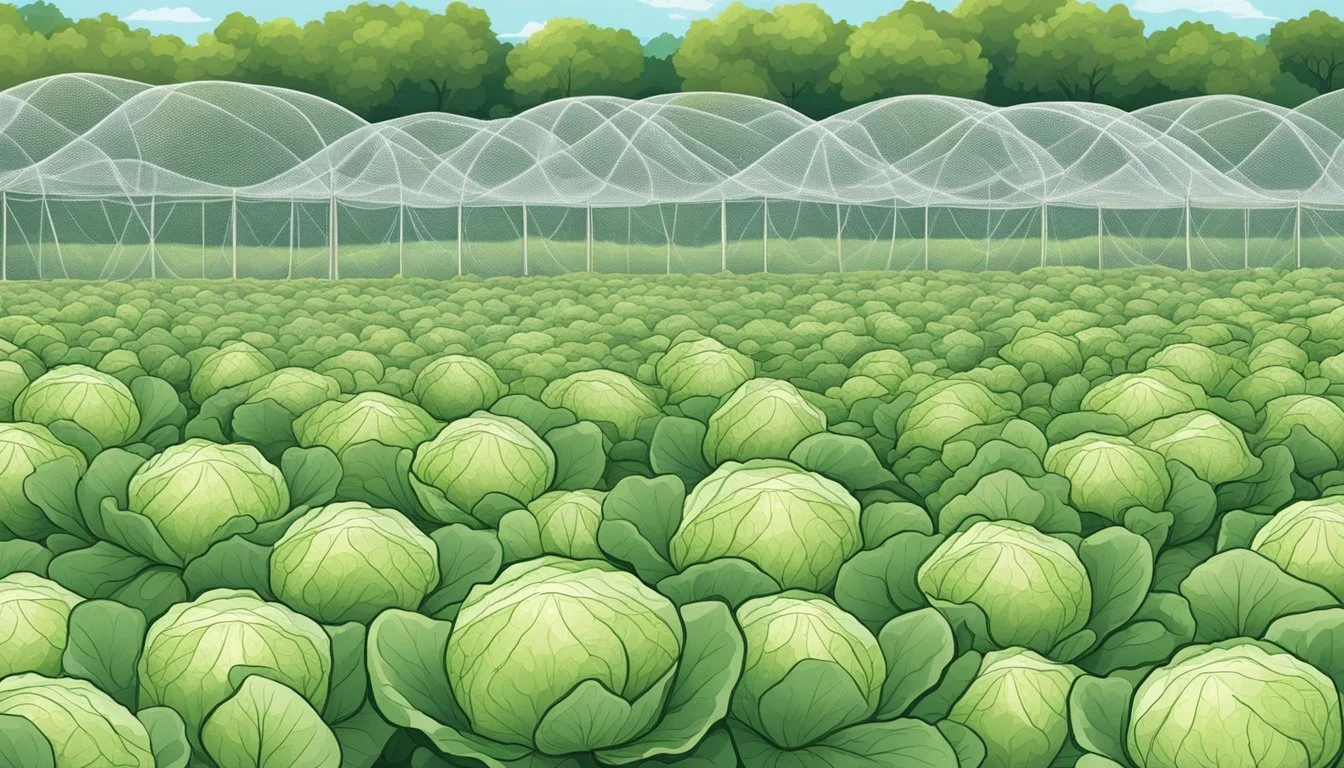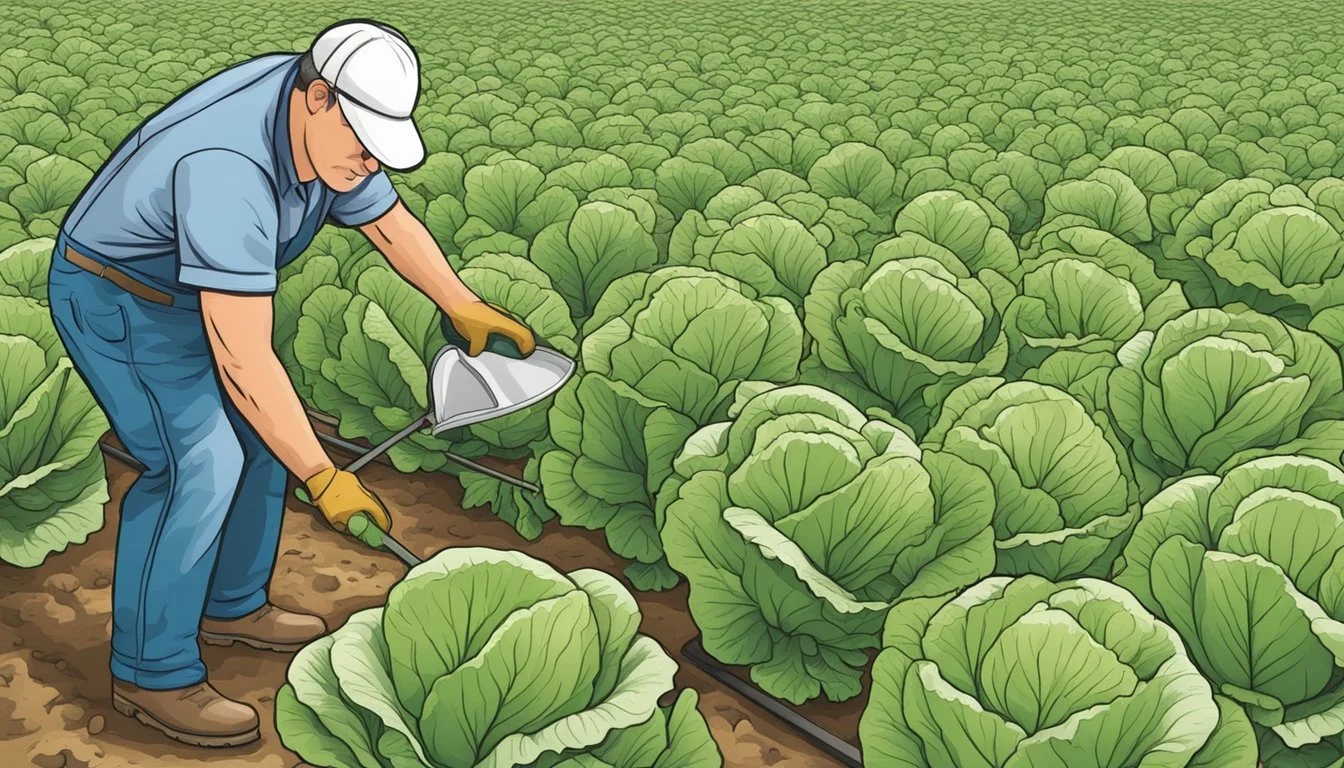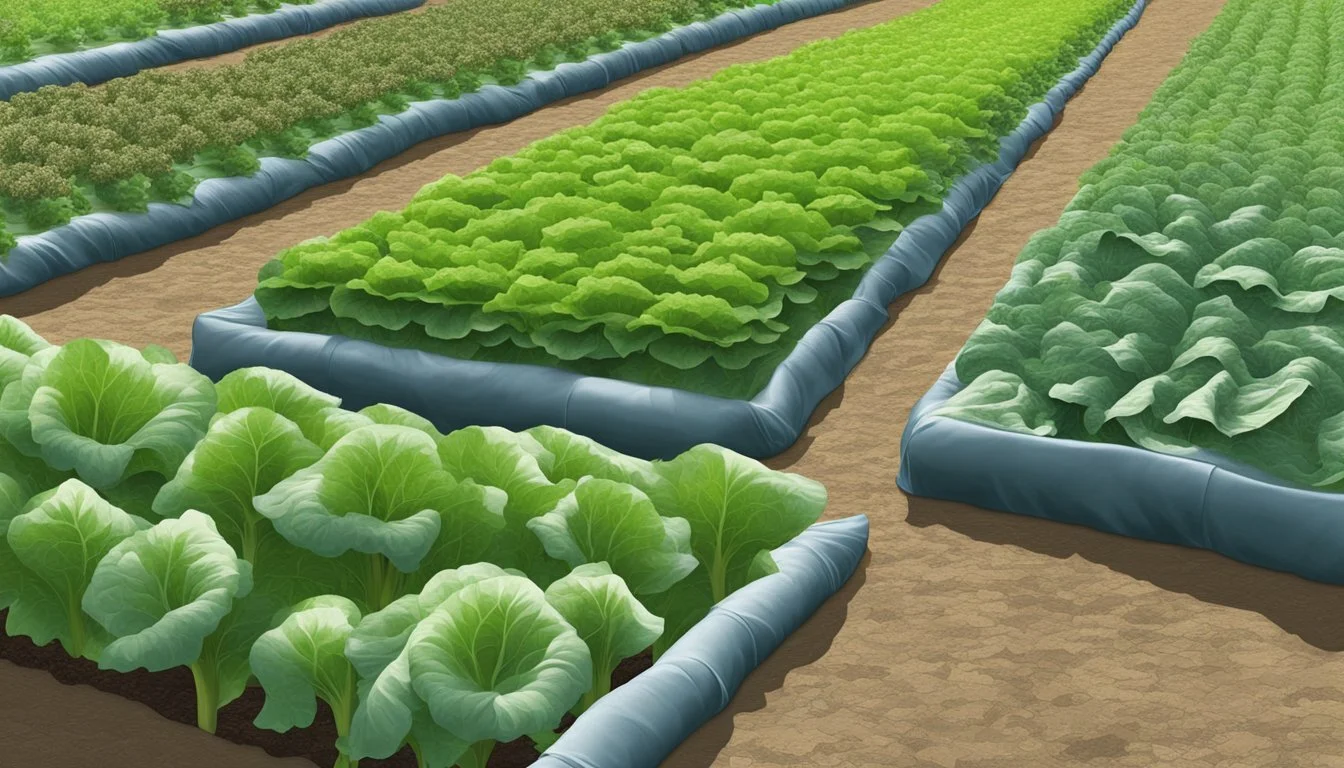Protecting Crops from Cabbage Maggots
Effective Strategies for Farmers
Protecting valuable crops from pests is a critical aspect of successful agriculture, and among these pests, cabbage maggots pose a significant threat, particularly to cole crops. These small, white larvae are the offspring of the cabbage root fly and can wreak havoc on the roots of plants such as cabbage, broccoli, radishes, and turnips. As they burrow into the soil and feed on the fibrous roots, they not only stunt the plants' growth but can also lead to the total loss of the crop if not managed effectively.
Cabbage maggots thrive in cooler, moist soil conditions, typically where cole crops are cultivated. Gardeners and commercial growers alike must be vigilant, as these maggots can go unnoticed due to their subterranean habitat until the damage becomes noticeable above ground. Yellowing and wilting leaves are often the first visible signs of a cabbage maggot infestation, necessitating immediate attention to prevent extensive damage.
Implementing proactive strategies and monitoring techniques is key to defending crops against cabbage maggots. Early detection and identification are paramount for minimizing harm and for guiding the choice of control measures. By employing preventive practices such as crop rotation, soil treatment, and timely planting, growers can mitigate the risks and protect their cole crops from the destructive effects of cabbage maggot infestations.
Understanding Cabbage Maggots
Cabbage maggots pose serious threats to cruciferous crops by damaging the roots and impacting plant health. This section explores the life cycle of these pests and the signs of their presence.
Life Cycle of Cabbage Maggots
The cabbage maggot (Delia radicum) progresses through distinct stages: egg, larva (maggot), pupa, and adult. Eggs are laid at the base of plants, often crucifers, and hatch within days. As larvae, they burrow into the soil and begin feeding on the plant's roots. After several weeks, they transform into pupae in the soil, eventually emerging as adult flies ready to reproduce and continue the cycle. This process is particularly problematic during spring and can coincide with the planting of seedlings.
Identifying Signs of Infestation
To identify an infestation, gardeners should look for telltale signs in their crops. Damage typically presents as wilting or yellowing leaves, a direct result of the maggots feeding on the plant's roots. A closer examination might reveal the small, white legless maggots around the roots. Mature plants may show signs of stunted growth, or in severe cases, plants may perish due to substantial root damage. Understanding these symptoms is crucial for timely interventions to protect crops from further harm.
Cultural Control Strategies
In order to protect crops effectively from cabbage maggots, it is essential to implement robust cultural control strategies. These strategies aim to disrupt the lifecycle of the pest and create unfavorable conditions for their survival and reproduction.
Crop Rotation and Planting Schedules
Crop rotation is an integral practice for disrupting the cycle of cabbage maggots. By alternating the types of crops grown in a particular field, farmers can reduce the buildup of cabbage maggot populations. It is advisable to rotate cole crops with non-susceptible crops to prevent the maggots from having a continuous food source. Additionally, adjusting planting schedules can avoid peak periods of adult fly emergence, thereby reducing the likelihood of egg-laying on young, vulnerable plants.
Soil Management and Tillage
Soil management practices, including tillage, play a significant role in controlling cabbage maggots. Tillage helps to destroy the pupae by bringing them to the surface, where they are exposed to predators and unfavorable climatic conditions. By reducing the amount of organic matter on the soil surface, which can serve as a breeding ground for the flies, farmers can limit the potential for infestation. Moreover, the maintenance of a weed-free environment through regular weeding can eliminate alternative host plants for the pest. Proper soil management ensures a reduction in favorable habitats for cabbage maggots, safeguarding cole crops and other susceptible crops.
Physical and Mechanical Control Methods
Efficient management of cabbage maggots can significantly reduce crop damage. Physical and mechanical control methods such as using row covers and manual removal techniques are effective strategies for protecting brassica crops without the use of chemicals.
Using Row Covers
Using row covers is a preventive measure to protect brassica crops from the cabbage root maggot. One effective type is floating row covers, which are lightweight fabrics placed over the crops. These covers allow light and moisture to reach the plants while keeping pests out. It is crucial to secure the edges of the row covers with soil or heavy objects to prevent adult flies from laying eggs near the root zone.
Manual Removal Techniques
Manual removal involves periodically inspecting the roots for maggots and removing them by hand. In conjunction with this, cabbage collars can be placed around the stem at soil level to deter egg-laying. Regular monitoring and agile response are essential to this practice, ensuring the removal of maggots before they cause extensive damage.
Biological Control Approaches
In the realm of agriculture, biological control offers an effective and environmentally friendly strategy for managing cabbage maggot infestations. This segment explores the varied natural organisms at the frontline of controlling these pests.
Beneficial Insects and Nematodes
Beneficial nematodes, specifically the species Steinernema feltiae, are integral in cabbage maggot management. When applied to the soil, these nematodes actively seek out and infect cabbage maggot larvae. Their mode of action involves entering the pest's body and releasing symbiotic bacteria that kill the host. This method must be carefully timed to coincide with the presence of cabbage maggot larvae for maximum effectiveness.
Wasps, particularly parasitic species like Trybliographa rapae, lay their eggs inside the maggot larvae. Upon hatching, the wasp larvae consume the maggots from the inside, thus controlling their population. These wasps are a crucial player in the natural biological control methods, as they specifically target the pests while leaving the crops unharmed.
Natural Predators and Pathogens
A variety of birds act as natural predators to the cabbage maggot. Species such as robins and other ground-foraging birds consume the larvae and pupae found in or on the soil. These avian allies can help reduce pest populations, although their contribution may not always be sufficient to control a severe infestation.
Pathogens, including certain fungi and bacteria, are potential biocontrol agents against the cabbage maggot. The bacterium Bacillus thuringiensis produces toxins that are fatal to a variety of insect pests, including the larvae of the cabbage maggot. Meanwhile, fungi like Metarhizium anisopliae can infect and kill these insects by penetrating their exoskeleton and disrupting internal functions. However, environmental conditions must be suitable for these pathogens to thrive and be effective against the targeted pest.
The deployment of these biological agents must be part of an integrated pest management strategy to sustainably manage cabbage maggot populations.
Chemical Control Options
When it comes to managing cabbage maggots, chemical control options offer a line of defense that can significantly mitigate damage to crops. These methods should be used as part of an integrated pest management approach to minimize impact on the environment and non-target organisms.
Insecticides and Pesticides
Insecticides are commonly used to combat cabbage maggot infestations. A variety of chemical options are available, and the efficacy of each depends on several factors, including the timing of application and the life cycle of the cabbage maggot. For example, one of the alternatives to the phased out chlorpyrifos-based insecticides is the use of alternative pesticides with a lesser environmental footprint while maintaining effectiveness against this pest. Pesticides that have specific action against the larvae can help protect crops while avoiding broader ecological damage.
Applying Soil Drenches
Soil drenches are a targeted method of applying chemical treatments directly to the soil where cabbage maggots are present. A drench typically involves a liquid pesticide or insecticide formulation that is diluted with water and then applied around the base of the plants. The concentration and volume of the drench must be carefully managed to ensure that the treatment reaches the root zone where the maggots reside without harming the plant or beneficial organisms in the surrounding soil. Soil drenches can offer localized control and are particularly useful in the early stages of infestation when larvae are actively feeding on the roots. These treatments can be crucial preventive measures during the peak egg-laying periods of the cabbage maggot flies.
Monitoring and Detection
Effective protection against cabbage maggots starts with diligent monitoring and accurate detection. Farmers and gardeners should implement strategies that allow early identification of the pests to minimize crop damage.
Sticky Traps and Visual Inspection
Sticky traps are a reliable tool for monitoring adult cabbage root fly activity. These traps can be coated with a substance to capture the adult flies when they arrive in the growing area. To maximize their effectiveness, traps should be placed near the soil surface, because the cabbage root fly tends to fly low. Regular inspection of these traps can indicate the beginning of fly activity and the potential risk to the crops.
Visual inspection is equally important; farmers should look for signs of eggs on the lower stems of host plants or in soil cracks near the plants. These eggs are small, so close attention is needed to spot them. The presence of eggs signals that appropriate control measures should be taken immediately to prevent the larvae from damaging the plant roots.
Cabbage Root Maggot Forecasting
Forecasting for cabbage maggot infestations typically makes use of degree-day models which can predict the emergence of adult flies based on soil temperatures. Monitoring tools and techniques are critical in predicting the timing for egg-laying and subsequent larval activity. When integrated with sticky traps data, forecasting models give farmers an advantage by providing an optimal timeline for implementing protective measures against this pest.
Non-Chemical Prevention Measures
In the realm of agriculture, preemptive strategies are paramount for safeguarding crops against pests like the cabbage maggot, without resorting to synthetic chemicals. Such measures enhance the overall health of the plant and the environment, thereby reducing the likelihood of infestation.
Sanitation and Exclusion
Sanitation plays a crucial role in preventing cabbage maggot infestations. Farmers should remove and destroy crop residues immediately after harvest to eliminate potential breeding grounds for the cabbage root fly. Thoroughly cleaning the field between planting seasons can significantly reduce the number of eggs and larvae that overwinter in the soil.
Exclusion methods involve creating physical barriers. The use of row covers can effectively protect young plants from being targeted by cabbage root fly adults looking to lay eggs. It is essential that the edges of these covers are securely buried or fastened to prevent adult flies from gaining access to the soil beneath the plants.
Organic Amendments and Mulching
Incorporating organic amendments into the soil can boost soil health and make plants less susceptible to pests. The addition of nutrient-rich compost enhances soil structure and fertility, supporting stronger plant growth, which can naturally ward off cabbage maggots and other pests.
Mulching is another effective strategy for protection against cabbage maggots. Applying a thick layer of organic mulch around the base of plants can deter females from laying eggs by making it more difficult for them to reach the soil. Materials such as straw or finely ground bark prove beneficial not only for this purpose but also for retaining soil moisture and temperature regulation.
Integrated Pest Management (IPM)
Integrated Pest Management (IPM) is a science-based, decision-making process that identifies and reduces risks from pests and pest management related strategies. It involves coordinated use of pest and environmental information along with available pest control methods, including cultural, biological, genetic, and chemical methods to prevent unacceptable levels of pest damage by the most economical means, and with the least possible hazard to people, property, and the environment.
IPM Strategies for Cabbage Maggot Control
Crop Monitoring: Regular field scouting allows for the timely detection of cabbage maggots. Threshold levels should be established to decide when control measures should be initiated.
Cultural Controls: Implementing crop rotations with non-host plants can disrupt the life cycle of the cabbage maggot. Using physical barriers, such as row covers, can effectively prevent adult flies from laying eggs near the plants.
Biological Controls: Encouraging natural enemies of the cabbage maggot, such as predatory beetles, can aid in keeping the pest population in check.
Chemical Controls: In situations where other methods are not sufficient, the judicious use of insecticides may be necessary. It's important to apply them in a manner that minimizes the risk to non-target organisms and the environment.
IPM Planning and Record Keeping
IPM Plan Development: An effective IPM plan is proactive in design and considers all available control methods. It should address particular vulnerabilities of the cabbage maggot and integrate practices to mitigate these vulnerabilities.
Record Keeping: Detailed records should be kept of pest populations, management actions taken, crop rotations, and the efficacy of different strategies. These records can provide invaluable information for making informed decisions in both the current and future growing seasons.
Environmental Impact and Considerations
Protecting crops from cabbage maggots requires a balance between effective pest management and minimizing harm to the environment. The implementation of ecological and regulatory measures ensures the safety of non-target species and compliance with safety guidelines.
Ecological Effects of Control Methods
Pesticide use presents risks to non-target organisms in the environment. For instance, the implementation of a pesticide risk reduction strategy emphasizes the importance of considering beneficial insects and pollinators during treatment against cabbage maggots. Alternative control methods, such as using appropriate insecticides like Success, which is applied as a drench, can provide targeted control while potentially reducing environmental impact.
Biotic Factors:
Beneficial organisms may be affected.
Cabbage maggot predators need protection.
Abiotic Factors:
Soil and water can be contaminated.
Residues may persist in the ecosystem.
Regulatory and Safety Guidelines
In response to the neurological impacts of certain pesticides on humans, regulatory bodies like the Oregon Department of Agriculture have introduced rules phasing out the use of chlorpyrifos. This regulation exemplifies the shift towards safer pest management practices. Compliance with regulatory standards ensures that farmers apply pesticides within legal and safe parameters, thereby safeguarding human health and preserving ecological integrity.
Regulatory Compliance:
Pesticide application must follow governmental regulations.
Bans on specific chemicals impact pest management strategies.
Safety Practices:
Safety data sheets guide proper handling of pesticides.
Personal protective equipment is used during pesticide application.
Through these efforts, farmers are encouraged to adopt integrated pest management strategies, which combine biological, cultural, and chemical methods to manage cabbage maggot populations effectively while prioritizing environmental and personal safety.
Economic Aspects of Cabbage Maggot Management
The financial implications of controlling cabbage maggots are significant, factoring into both the expenditure on preventative and curative actions and the crop revenue by way of yield and quality.
Cost Analysis of Control Measures
Preventative Strategies:
Seed Treatment: The application of insecticide treatments directly to seeds, averages a certain cost per hectare but can result in reduced early damages.
Cultural Practices: Costs incurred include crop rotation and sanitation practices, which may reduce infestation but require additional labor and planning.
Chemical Controls:
Insecticides: Regular applications of insecticides such as Success insecticide offer protection against cabbage maggots. These treatments incur costs both for the chemical product and the application process, which varies with the size of the area treated and frequency of application.
Impact on Crop Yields and Quality
Yield Loss: Infestation can lead to substantial yield reduction, where heavy larval activity can cause plant death.
Quality Degradation: Larval damage may prompt bacterial soft rot and black leg, thereby compromising the commercial value of Brassica crops, as noted by practices at the Pest Management Centre.
In sum, the economic impact is twofold: direct costs associated with implementing management strategies and the potential reduction in crop yields and quality due to damage, which in turn affects revenue.
Frequently Asked Questions
The following subsections address common inquiries about combating cabbage maggots, the damage they cause, health concerns, natural predators, biological controls, and preventative measures.
How can you get rid of cabbage maggots effectively?
One can eradicate cabbage maggots by applying beneficial nematodes to the soil, which target maggot larvae. It's recommended to apply diatomaceous earth around the base of plants to deter adult flies from laying eggs.
What damages do cabbage maggots cause to plants?
Cabbage maggots primarily damage the roots of cole crops, leading to yellowing, stunting, and potentially the death of the plant. Severe infestations can result in extensive root tunneling and increased susceptibility to disease.
Can cabbage maggot infestation be harmful to human health?
Cabbage maggot infestation is generally not harmful to humans, as the issue is plant-focused. However, the maggots can compromise crop health and yield, impacting food supply and economic stability within the agricultural sector.
Which predators can naturally control cabbage maggot populations?
Natural predators such as rove and ground beetles can effectively manage cabbage maggot populations by feeding on the larvae and eggs.
What are the most effective biological controls for managing cabbage maggots?
Biological controls like introducing parasitic wasps, which lay their eggs inside cabbage maggot larvae, have proven effective. Bacillus thuringiensis, a natural soil-dwelling bacterium, can also be applied as a microbial insecticide.
In what ways can you prevent cabbage root fly infestations?
Gardeners can prevent cabbage root fly infestations by covering plants with floating row covers to block adults from laying eggs. Crop rotation and removing plant debris post-harvest are also essential practices to reduce risks of infestation.








